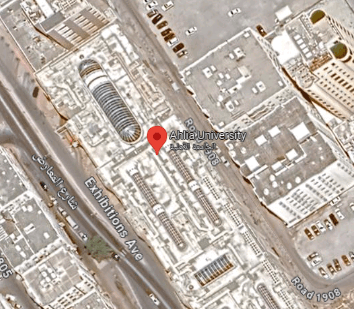Carbon Footprint
This report presents an assessment of the carbon footprint of Ahlia University (AU) for the year 2022. The carbon footprint is a measure of the total greenhouse gas emissions produced directly and indirectly by an organization, in this case, AU. The analysis aims to identify the main sources of emissions and opportunities for reduction, reflecting AU’s commitment to sustainability and environmental responsibility.
Methodology
The carbon footprint assessment follows the principles outlined in the Greenhouse Gas Protocol (GHG Protocol) developed by the World Resources Institute (WRI) and the World Business Council for Sustainable Development (WBCSD). The scope of the assessment includes three main categories of emissions:
- Scope 1: Direct Emissions: This includes emissions from on-campus sources that are directly controlled by AU, such as emissions from university-owned vehicles and stationary combustion (e.g., boilers).
- Scope 2: Indirect Emissions from Electricity Consumption: This includes emissions associated with electricity purchased and consumed by AU.
- Scope 3: Other Indirect Emissions: This category covers emissions from activities indirectly related to AU, such as employee commuting, waste generation, and business travel.
Scope | Emissions source |
|---|---|
Scope 1 | |
Fuels used in Ahlia owned vehicles | |
Fuels used in equipment and machinery | |
Scope 2 | Electricity consumption
|
Cold supply | |
Scope 3 | |
Business travel | |
Rental cars
| |
Waste
| |
Results
Based on the data collected and calculations performed, the total carbon footprint of Ahlia University for the year 2022 is 9.627,60 emissions in CO2e. The breakdown of emissions by scope is as follows:
|
Emissions source |
2021 |
2022 |
2024 |
|
|
Scope 1 |
Fuels used in Ahlia owned vehicles |
1.209,13 |
1.195,75 |
1037.98 |
|
Fuels used in equipment and machinery |
569,00 |
537,22 |
196.75 |
|
|
Scope 2 |
Electricity consumption |
5.198,42 |
4.784,92 |
4471.31 |
|
Cold supply |
2.123,30 |
1.954,40 |
1625.14 |
|
|
Scope 3 |
Business travel |
1.155,79 |
982,02 |
847.26 |
|
Rental cars |
135,97 |
115,53 |
103.67 |
|
|
Waste |
67,99 |
57,77 |
49.84 |
|
2021 |
2022 |
2024 |
% Change (2021�2024) |
|
|
Total Scope 1 |
1.778,13 |
1.732,97 |
1234.73 |
-30.6% |
|
Total Scope 2 |
7.321,72 |
6.739,32 |
6096.45 |
-16.7% |
|
Total Scope 3 |
1.359,75 |
1.155,31 |
1000.77 |
-26.4% |
|
Total net emissions |
10.459,60 |
9.627,60 |
8331.95 |
-20.3% |
Interpretation by Scope
Scope 1 - Direct Emissions
- Represents emissions from on-campus fuel use, such as generators, university-owned vehicles, and HVAC refrigerants.
- Declined by 30.6%, which shows effective policies such as:
- Reduced fuel usage or transition to cleaner fuels
- More efficient fleet or generator usage
- Improved refrigerant management or equipment upgrades
Scope 2 - Purchased Electricity
- Reflects emissions from grid electricity consumption.
- Declined by 16.7%, due to:
- Energy-saving initiatives (LEDs, motion sensors, HVAC upgrades)
- Possible partial adoption of solar or off-grid solutions
- Behavioral changes (e.g., fewer in-person classes or optimized schedules)
Scope 3 - Indirect Emissions
- Includes emissions from commuting, business travel, procurement, and waste.
- Declined by 26.4%, influenced by:
- Increased remote work/study options
- More efficient supply chain decisions
- Improved waste segregation and recycling
Overall Trend (2021 → 2024):
- Net emissions dropped by ~20.3%, reflecting a steady downward trend in all categories.
- This signals strong institutional efforts toward sustainability.
- Scope 1 shows the steepest decline, while Scope 2 remains the largest contributor.
Discussion
The carbon footprint assessment highlights key areas of emissions for Ahlia University, indicating opportunities for reducing its environmental impact. Strategies to decrease the carbon footprint may include:
1. Adopting Renewable Energy Sources: Increasing the use of renewable energy for electricity consumption can significantly reduce Scope 2 emissions.
2. Promoting Sustainable Transportation: Encouraging sustainable commuting options for employees and promoting the use of electric or hybrid vehicles can help lower Scope 1 emissions.
3. Implementing Waste Reduction and Recycling Programs: Enhancing waste management practices can mitigate Scope 3 emissions associated with waste generation.
4. Encouraging Virtual Meetings and Remote Work: Reducing business travel by utilizing virtual meeting platforms and supporting remote work options can reduce Scope 3 emissions.
Conclusion
The carbon footprint assessment provides valuable insights into AU's greenhouse gas emissions and serves as a foundation for implementing targeted sustainability initiatives. By addressing the identified sources of emissions and embracing sustainable practices, Ahlia University can strengthen its commitment to environmental stewardship, contribute to climate change mitigation efforts, and serve as a role model for sustainability within the academic community and beyond.




